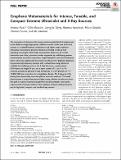Graphene Metamaterials for Intense, Tunable, and Compact Extreme Ultraviolet and X‐Ray Sources
Author(s)
Pizzi, Andrea; Rosolen, Gilles; Wong, Liang Jie; Ischebeck, Rasmus; Soljacic, Marin; Feurer, Thomas; Kaminer, Ido; ... Show more Show less
DownloadPublished version (1.154Mb)
Publisher with Creative Commons License
Publisher with Creative Commons License
Creative Commons Attribution
Terms of use
Metadata
Show full item recordAbstract
© 2019 The Authors. Published by WILEY-VCH Verlag GmbH & Co. KGaA, Weinheim The interaction of electrons with strong electromagnetic fields is fundamental to the ability to design high-quality radiation sources. At the core of all such sources is a tradeoff between compactness and higher output radiation intensities. Conventional photonic devices are limited in size by their operating wavelength, which helps compactness at the cost of a small interaction area. Here, plasmonic modes supported by multilayer graphene metamaterials are shown to provide a larger interaction area with the electron beam, while also tapping into the extreme confinement of graphene plasmons to generate high-frequency photons with relatively low-energy electrons available from tabletop sources. For 5 MeV electrons, a metamaterial of 50 layers and length 50 µm, and a beam current of 1.7 µA, it is, for instance, possible to generate X-rays of intensity 1.5 × 107 photons sr−1 s−1 1%BW, 580 times more than for a single-layer design. The frequency of the driving laser dynamically tunes the photon emission spectrum. This work demonstrates a unique free-electron light source, wherein the electron mean free path in a given material is longer than the device length, relaxing the requirements of complex electron beam systems and potentially paving the way to high-yield, compact, and tunable X-ray sources.
Date issued
2019Department
Massachusetts Institute of Technology. Department of PhysicsJournal
Advanced Science
Publisher
Wiley